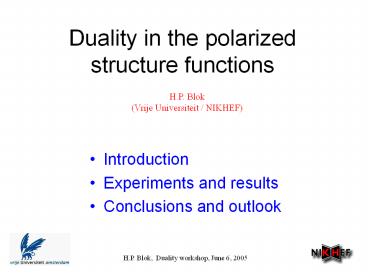Duality in the polarized structure functions - PowerPoint PPT Presentation
Title:
Duality in the polarized structure functions
Description:
resonance vs. background. H.P. Blok, Duality workshop, June 6, 2005. 3. Polarized ... Duality must fail for Q2 0 (GDH sum rule 0; Ellis-Jaffe sum rule 0) ... – PowerPoint PPT presentation
Number of Views:23
Avg rating:3.0/5.0
Title: Duality in the polarized structure functions
1
Duality in the polarizedstructure functions
H.P. Blok (Vrije Universiteit / NIKHEF)
- Introduction
- Experiments and results
- Conclusions and outlook
2
Duality
- Resonance averaged (which) scaling ?
- Relevance
- theoretical QCD structure, higher twist
- experimental higher x
- Belief or hold?
- p vs. n, L vs. T, s3/2 vs. s1/2 , semi-incl.,
excl.? - global, local?
- resonance vs. background
3
Polarized
Lepton asymmetries measured
Deduce photon asymmetries A1 and A2
4
Relation to spin structure functions g1 and g2
g2 Q2/n2 4M2x2/Q2
5
For proton A1 ( g1) gt 0 at high Q2 At low Q2
negative values in the resonance region,
especialy for the D ? Duality must fail for Q2
? 0 (GDH sum rule lt 0 Ellis-Jaffe sum rule gt
0) g2 Burkhardt-Cottingham sum rule
6
High Q2 data for g1
7
The extended GDH sum rule
K equivalent photon energy (n?...)
At large Q2
For Q2 ? 0
8
Global behaviour for the proton
9
Experiments and results
SLAC Abe et al., PRL 78 (1997) 815 Ee 9.7
GeV 4.50 and 70 NH3 and ND3 targets, A// W2 lt
5 GeV2, Q2 0.5 and 1.2 GeV2 Abe et al., PR D58
(1998) 112003 Ee 16.2, 29.1 GeV (high Q2), A//
and A?, g2
10
SLAC results
0.5 GeV2
1.2 GeV2
p
n
d
p
11
Hermes Airapetian et al., PRL 90 (2003)
092002 HERA positron beam, Ee 27.6 GeV, Pe ?
0.55 gas cell fed by ABS (P ? 0.88) Hermes
spectrometer (20 110) A// ? A1 (using SLAC
estimate for A2) 1 lt W2 lt 4 GeV2, Q2 1.2 12
GeV2
12
(No Transcript)
13
Comparison of G1res/ G1DIS in same x (or ?) range
? 2x / 1(1g2)1/2
What to use for DIS at low Q2? Assume A1 for DIS
independent of Q2, take F1 from exp.
14
Comparison of G1res/ G1DIS in same x range
Use PDF
Bianchi, Fantoni Liuti, PR D69 (2004) 014505
15
JLab (CLAS) Fatemi et al., PRL 91 (2003)
222002 Ee 2.6 and 4.3 GeV, Pe ? 0.70 NH3
target (P ? 0.70 ? 0.40) A// ? A1 (with model
for A2) 1 lt W2 lt 6 GeV2, Q2 0.15 1.64
GeV2 Yun et al., PR C67 (2003) 055204 Ee 2.5
GeV, Pe ? 0.72 ND3 target (P ? 0.10 0.25) A//
? A1 (with model for A2) 1 lt W2 lt 4 GeV2, Q2
0.27 1.3 GeV2
16
proton data
17
proton data
18
deuteron data
19
JLAB Hall A Amarian et al., PRL 92 (2004)
022301 Ee 0.86 5.06 GeV 15.50
3He target, A// and A? Q2 0.10 0.90
GeV2 Wandzura-Wilczek holds globally Burkhardt
-Cottingham (incl. elastic!) holds
? x
20
SLAC Anthony et al., PhL 553B (2003) 18 g2p and
g2n mainly high Q2 0.7 lt Q2 lt 20 GeV2
Wandzura-Wilczek appr. ok
Burkhardt-Cottingham for proton violated?
(low x behaviour)
21
Conclusions and outlook
- Duality in g1?
- globally for Q2 ? 1.5 GeV2 ?
- locally for W ? 1.6 GeV ? (not D and S11)
- (consequences for high x measurement?)
- Better fulfilled for A1?
- Look in more detail into bumpology
- contribution resonance vs. background
- W-dependence (especially D and S11 region)
- (compare also with e.g. MAID)
- (Much/many) more accurate data
22
Outlook more data (JLab)
Hall A (Patricia Solvignon) Ee 3.0 , 4.0,
5.0 GeV 1.0 lt W lt 2.1 GeV, Q2 ? 1.0 4.0
GeV2 3He target, A// and A? ? A1n and g1n
Hall B (Yelena Prok) Ee 1.6, 2.5, 4.2, 5.7
GeV 0.8 lt W lt 3.0 GeV, Q2 ? 0.05 4.5 GeV2 NH3
and ND3 target, A//p,d Hall C (Mark
Jones) Ee 5.75 GeV, 0.8 lt W lt 2 GeV, Q2 ? 1.3
GeV2 NH3 and ND3 target, A//p,d and A?p,d,
g1p,n and g2p,n
23
proton data
24
The extended GDH sum rule
25
SLAC Q2 dependence for different x values































